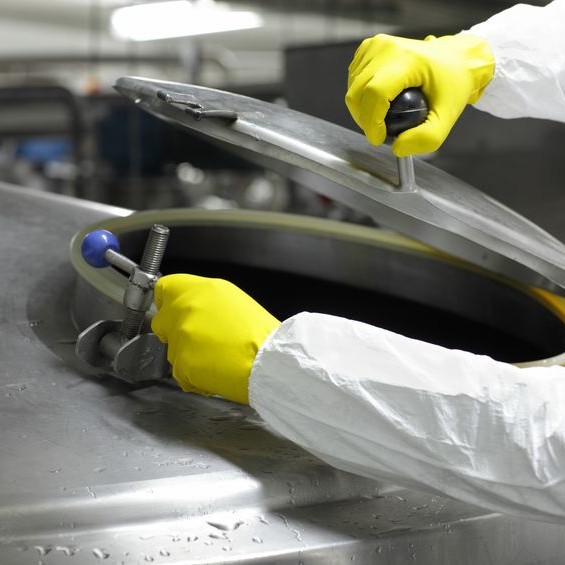
Hygienic Design of Tanks
What is the Hygienic Design of Tanks?
Tanks are integral components of industrial bakeries. They are used in different stages of production, from storage of ingredients to fermentation in breadmaking dough systems.
The hygienic design of tanks encompasses the principles, strategies and engineering aspects that must be applied in the design phase of a tank so that it does not become a contamination source for the food products handled in the plant. Prevention of biological, physical and chemical hazards that may originate from the equipment is key when designing and constructing tanks.
How does it work?
The main purpose of a tank is to hold or contain food materials (ingredients or finished products) whether in solid, gas or liquid state. In high-speed bakeries, tanks come in direct contact with food.
The concept of tanks in a bakery is rather wide. There can be tanks that fit into the closed equipment concept and others that are open-type equipment:
- Mixing and fermentation tanks for liquid sponges: Closed type, usually fitted with CIP systems
- Holding tanks: closed type, usually fitted with CIP systems
- Vertical silo-tanks for bulk storage of liquid ingredients: can be designed, constructed and installed to be CIP
- Troughs for bulk fermentation of plastic sponges: open type
- Mixer tank or bowl: open type
Principles/guidelines for hygienic design of tanks:1,2
- All tank food contact surfaces should be smooth, impervious to water, free of cracks and crevices, nonporous, nonabsorbent, non reactive, corrosion resistant, and nontoxic.
- Tanks should be cleanable and should allow for an easy and quick cleaning using normal tools either by CIP (e.g. rotary splay ball, tank jets or nozzles) or manually.
- Only 300 series stainless steel material should be used in the construction of tanks.
- The stainless steel should withstand normal cleaning and processing conditions. The tank’s surfaces should resist to a reasonable extent abrasive detergents, chlorine and related sanitizers, acids, and a wide range of temperatures (hot and cold).
- Avoid using construction materials such as carbon steel, copper and brass because they are not considered hygienic in bakeries. They may also catalyze breakdown reactions in fat-rich products (e.g. oils, cocoa butter and shortenings).
- Tanks should be designed, constructed and installed to be self-draining to ensure that product, water, or cleaning solutions do not accumulate, pool, or condense on equipment or product zone areas.
- Tanks product-contact surfaces should be free of holes, pores, cracks, inclusions, rough edges, incrustations and other surface imperfections detectable by visual and tactile inspections. The height of the surface roughness should not be greater than 0.8 microns (Ra ≤ 0.8 μm).
- Tanks with dismountable joints (e.g. some mixers for shaft and kneading arm components) should be designed, constructed and installed in such a way that prevent dead areas, crevices and/or any hard-to-access-and-clean surfaces.
- To prevent gaps and crevices, dismountable joints, such as fasteners, should be installed with well designed nuts or screw heads and resilient gaskets (plastic or from elastomer) that can create a hermetic seal between metal-to-metal surfaces.
- When possible, all mixer tank attachments should be connected to the tank’s internal body by permanent joints (continuous welding).
- Internal angles and corners of the tank should have a radius of at least 3 mm to allow a quick draining and cleaning (20 mm is optimum).
- Static tanks (those with large volumes and fixed position in a production line) should be installed with enough clearance from the floor’s surface to allow for easy inspection and cleaning of non-product contact surfaces and splash areas. They should have rounded pedestals and be sealed to the floor (e.g. by continuous/orbital welding).
Application
Tanks are designed based on the following criteria:
- Intended use of the equipment. Delimitation of use in terms of products to process (allergens, etc.) and unit operations (heat/mass transfer, mixing).
- Characteristics of the products that will be processed, e.g. moisture content, water activity, microbial stability, dough stickiness.
- Cleaning and sanitizing program that will be applied (e.g. CIP, wash-down, COP). Drainability of equipment is key for frequent cleaning cycles.
- Maintenance program that will be applied to the equipment.
- HACCP plan and preliminary hazard analysis.
- Risk assessment associated with each hazard identified.
- Design methods/measures which eliminate hazards and associated risks.
References
- Lelieveld, H.L.M.. “Hygienic Design of Food Processing Equipment.” Hygiene in Food Processing: Principles and Practice, 2nd edition, Woodhead Publishing Limited, 2014, pp. 91–130.
- Cramer, M.M. “Sanitary Facility Design.” Food Plant Sanitation: Design, Maintenance, and Good Manufacturing Practices, 2nd edition, CRC Press, Taylor & Francis Group, LLC, 2013, pp. 109–133.

